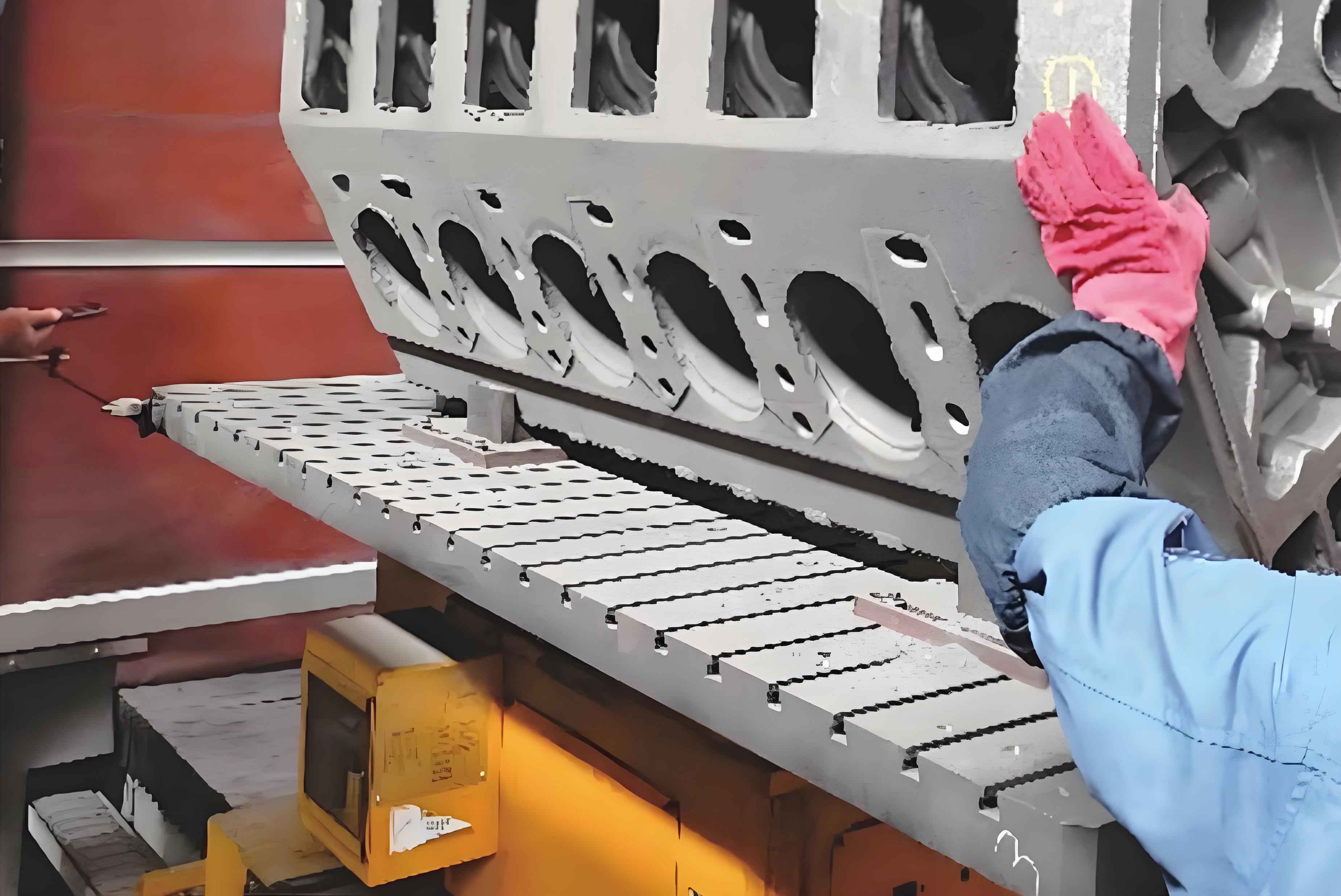The engine cylinder block is a critical component in automotive powertrains, demanding exceptional structural integrity and thermal management. With the increasing emphasis on lightweight design and stringent environmental regulations, achieving high-quality inner cavities—particularly in thin-walled engine cylinder blocks—has become a formidable challenge. This article systematically explores the key factors influencing inner cavity quality, including core sand materials, coatings, and sand-shooting simulation technologies, while proposing optimized process controls to mitigate defects such as veining, sand adhesion, and porosity.

1. Core Sand Materials and Their Impact on Engine Cylinder Block Quality
Core sand serves as the backbone for forming intricate internal geometries in engine cylinder blocks. Its thermal stability, expansion characteristics, and permeability directly affect the final casting quality.
1.1 Silica Sand with Additives
Silica sand (SiO₂ ≥ 91%) is widely used due to its cost-effectiveness and refractoriness. However, its phase transition at 573°C induces cracking, leading to veining defects. To address this, additives such as volatile cellulose (0.5–0.7%) and chromium spinel (35%) are incorporated:
- Cellulose: Burns out at high temperatures, creating voids to accommodate sand expansion.
- Chromium spinel (Cr₂O₃ ≥ 46%): Reduces metal penetration by forming a dense sintered layer.
Table 1: Performance Metrics of Core Sand Components
| Material | LOI (%) | Acid Demand (mL) | Moisture (%) | Clay (%) | Conductivity (μS/cm) | AFS |
|---|---|---|---|---|---|---|
| Silica Sand | ≤0.3 | ≤5.0 | ≤0.25 | ≤0.2 | ≤100 | 49–53 |
| Chromium Spinel | ≤1.5 | – | – | – | – | – |
The thermal expansion (αα) of silica sand can be modeled as:α=αSiO2+Δαadditivesα=αSiO2+Δαadditives
where ΔαadditivesΔαadditives represents the expansion-contributing effects of additives.
1.2 Sintered Ceramic Sand
To further reduce thermal expansion, sintered ceramic sand (5:3 ratio with silica sand) is employed. Its advantages include:
- Low thermal expansion (≤0.2% at 1,000°C)
- High permeability (18.6% improvement over pure silica sand)
- Cost reduction (23.5% lower than zircon sand)
Table 2: Properties of Sintered Ceramic Sand
| Property | Specification |
|---|---|
| LOI (%) | ≤0.2 |
| Thermal Expansion (%) | ≤0.2 (1,000°C) |
| Refractoriness (°C) | ≥1,760 |
| AFS | 38–44 |
The permeability (KK) of mixed sand is expressed as:K=Kceramic⋅ϕceramic+Ksilica⋅ϕsilicaK=Kceramic⋅ϕceramic+Ksilica⋅ϕsilica
where ϕϕ denotes volume fraction.
2. Coating Technologies for Enhanced Surface Integrity
Coatings act as barriers against metal penetration and thermal shock. Key parameters include thermal shock resistance, expansion coefficient, and sintering behavior.
2.1 Coating Composition and Performance
- Coating A: Composed of pyrophyllite, high-purity graphite, and spodumene.
- Advantages: Forms a continuous ceramic layer, reduces wettability, and exhibits negative thermal expansion.
- Coating B: Contains alumina-silicate and quartz powder.
- Drawbacks: Prone to cracking due to high thermal expansion.
Table 3: High-Temperature Performance of Coatings
| Coating | Thermal Shock Class | Expansion (%) | Sintering Behavior (1,000°C) |
|---|---|---|---|
| A | I | 1.605 | Dense layer formation |
| B | III | 1.848 | Cracking and spalling |
The thermal stress (σσ) in coatings is governed by:σ=E⋅α⋅ΔTσ=E⋅α⋅ΔT
where EE is Young’s modulus, αα is the expansion coefficient, and ΔTΔT is the temperature gradient.
3. Sand-Shooting Simulation for Optimized Core Density
Sand-shooting parameters critically influence core density and gas entrapment. Computational fluid dynamics (CFD) simulations optimize:
- Shooting head height
- Shooting pressure
Table 4: Impact of Shooting Parameters on Core Quality
| Parameter | Shooting Speed (m/s) | Core Density (g/cm³) |
|---|---|---|
| Head Height: 800 mm | 3.698 | 1.446 |
| Head Height: 500 mm | 3.773 | 1.452 |
| Pressure: 3 bar | 3.769 | 1.445 |
| Pressure: 5 bar | 5.937 | 1.434 |
The velocity (vv) of sand particles during shooting is approximated by:v=2(P−P0)ρv=ρ2(P−P0)
where PP is the shooting pressure, P0P0 is atmospheric pressure, and ρρ is sand density.
4. Conclusion
- Core Sand Optimization: Silica sand with cellulose and chromium spinel minimizes veining in 3 mm thin-walled engine cylinder blocks. Sintered ceramic sand enhances permeability and reduces costs.
- Coating Selection: Coating A outperforms Coating B due to superior thermal shock resistance and sintering behavior.
- Process Simulation: Sand-shooting simulations improve core density by 4.6%, resolving porosity in 2.5L 4-cylinder engine blocks.
This integrated approach ensures high-quality inner cavities in modern engine cylinder blocks, aligning with lightweight and eco-friendly manufacturing trends.
